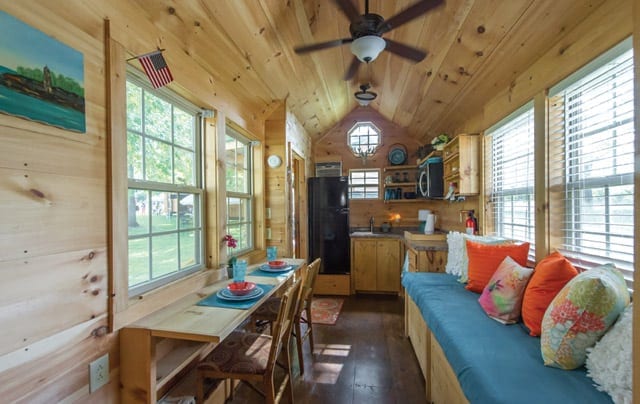Tiny Home Design and Inspiration

If you’ve ever watched HGTV’s “Tiny House Hunters” or “Tiny House, Big Living,” you’ve probably asked yourself: Could I actually live a tiny lifestyle? What’s this tiny house movement all about anyway?
According to Gary Hollingsworth of Clayton Tiny Homes, tiny houses represent a “less is more” approach to living. “Tiny homes are more about an attitude and a way of life than about space,” he says. “It’s about quality, not quantity.” That’s obviously true, as tiny homes typically offer a total of 100 to 400 square feet of living space. Regardless of the square footage, though, the concept remains the same. “I think people are looking for a simpler way to live. Life is chaotic enough, and all the excesses and gadgets haven’t seemed to make things better—just more complicated,” notes architect Jeffrey Dungan, who has partnered with Clayton Homes for its tiny house collection. “The appeal is related to freedom and our desire for autonomy.”
While you may not be ready to downsize in an extreme way, you can still find inspiration in tiny houses. Consider these design and space-saving tips to see if you could change how you live in a big way.
Pare It Down
“If you own a large space, then that space and your stuff will own you,” explains Will Johnston of Tiny House Atlanta, a nonprofit dedicated to helping individuals, groups and cities embrace the tiny house movement’s positive effects on neighborhoods. “In a tiny house, you’re not just shrinking your space—you’re shrinking your possessions.”
A great place to begin paring down what you have is your wardrobe. Johnston recommends checking out Be More with Less’ Project 333, a minimalist fashion challenge that prompts viewers to dress with 33 items or less over three months—box up the remainder of your wardrobe and learn to live with fewer clothes. When there’s less to store, living simply becomes easier.
The same concept can be applied to other items in your home. Get rid of things you haven’t used in the last three months and toss out duplicates. For a room-by-room guide to decluttering check out
The Tiny Life’s 30-Day Declutter Challenge.

For instance, Johnston observes, you can choose a table that converts into a chair or have a window that doubles as a movie screen for family time. In the Indigo tiny home from Driftwood Homes, Gunyou notes that a Murphy bed provides desk space with storage cubbies when it is folded up. With so many smart furniture pieces on the market (such as seating options like couches with hidden storage underneath the cushions), there are unlimited options to take the tiny-home concept to your rooms.

In the same vein as multifunctional furniture items, many design elements in your home can serve a secondary—and even hidden—purpose. Resende points to the use of storage hiding behind a backsplash in the kitchen as an excellent option, as well as storage space concealed behind a mirror in the bathroom or pictures on the wall.
What’s more, there are spaces in your home that can actually be converted into hidden storage. For instance, Resende suggests installing pullout drawers in the spare space behind the kick plates under your kitchen cabinets. Look around and strategize how to make the best use of every inch of space available to you.
“It’s rewarding to live well, and successfully living well in a smaller environment makes people feel smart,” says Baker. “It’s a home, not just a shelter. This is a hipster-like movement, but with purpose and finesse.”

In the 1970s, the average amount of space allotted for four people was 1,100 square feet. That number has ballooned to 2,600 square feet for two people today. However, most people only interact with approximately 250 square feet of space in their home regularly. Put markers down to show where you walk in your house every day—you might be surprised at the amount of space you
actually use.
You bought a tiny home. Now what? Not every community welcomes tiny homes, so it’s important to do your homework on where to park. Nonprofits Tiny House Atlanta or The American Tiny House Association are great resources.
American Tiny House Association | www.americantinyhouseassociation.org
Clayton Tiny Homes | www.claytonhomes.com
Driftwood Homes USA | www.driftwoodhomesusa.com
Jeffrey Dungan, Designer Cottages | www.designercottages.com
Lamon Luther | www.lamonluther.com
Prime Surfaces | www.primesurfacesgroup.com
Project 333 | www.bemorewithless.com
The Tiny Life | www.thetinylife.com
Tiny House Atlanta | www.tinyhouseatlanta.com


How can water leakage in my basement or crawlspace affect other areas of my home?

Editor’s Pick – January 2015

Award-Winning Kitchens, Baths, Interior Design and More

Atlanta’s NKBA Designs of Distinction 2019 Winners

100 Things to Know Before You Remodel

What’s the simplest way to upgrade your window treatments?







